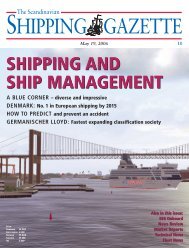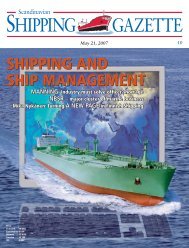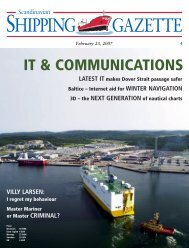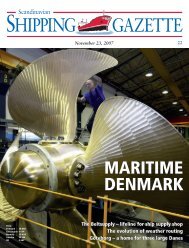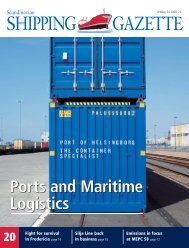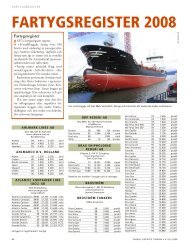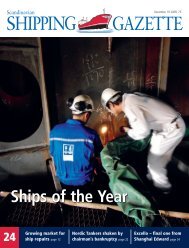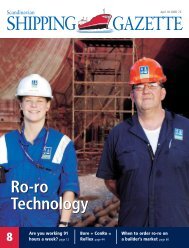SSG No 20 - Shipgaz
SSG No 20 - Shipgaz
SSG No 20 - Shipgaz
Create successful ePaper yourself
Turn your PDF publications into a flip-book with our unique Google optimized e-Paper software.
PorTs & MAriTiMe loGisTiCs<br />
transports. Time may show how this will<br />
turn out, but we expect that the share of<br />
goods carried on railway will reach some<br />
<strong>20</strong> per cent in quite a short time.”<br />
Growth potential<br />
Inside the port area the logistic areas are<br />
optimised for the actual types of cargo to<br />
be handled in the port. Both ro-ro and container<br />
handling require large areas for the<br />
storage of units. The infrastructure allows<br />
an estimated annual ro-ro handling capacity<br />
of between 700,000 and 800,000 trucks<br />
and trailers, compared to the estimate of<br />
470,000 units this year in the old facilities.<br />
The layout of the three container terminals<br />
allows the container handling capacity<br />
to increase hand in hand with the traffic<br />
growth by acquiring more cranes and handling<br />
equipment as well as by enlarging the<br />
storage areas.<br />
“The port area will be fully built out<br />
already from the beginning, but the equipment<br />
of the port operators will be dimensioned<br />
to the actual traffic”, explains Mr<br />
Nissinen.<br />
The harbour is designed for an annual<br />
container turnover of some 1.3 million<br />
TEUs. It is estimated that the port of Helsinki<br />
will handle some 440,000 TEUs in<br />
<strong>20</strong>07. Only about three per cent of the containers<br />
handled in Helsinki are related to<br />
transit traffic.<br />
“Transit containers require more space as<br />
the average storage time for a transit container<br />
in the port area is about a week. A<br />
container with goods for Finland stays no<br />
more than three or four days in the port,”<br />
informs Mr Nissinen.<br />
In the Vuosaari Harbour there will also<br />
be facilities for importing cars. From 25,000<br />
to 30,000 cars are imported in the port of<br />
Helsinki annually, and they are exclusively<br />
intended for the Finnish market.<br />
Port development<br />
Risk Assessment<br />
PorT of Helsinki<br />
“We see a growth potential in this business.<br />
In Finland about 140,000 new cars<br />
are registered each year. Of these 40 per<br />
cent are sold in the Helsinki area.”<br />
Flexibility<br />
In the Vuosaari-project the fact that the<br />
world is likely to change quite a lot during<br />
the long time the port will be operational<br />
is of course also taken into consideration.<br />
The quays are therefore designed for both<br />
container and ro-ro traffic.<br />
“In this way we will be prepared for<br />
future changes in the structure of the cargo<br />
volumes. It is most certain that changes<br />
will occur in the shares between rubber<br />
tyre units and containers during the decades.”<br />
The fairway depth of 11 m allows calls<br />
of container vessels with a capacity up to<br />
2,500 TEUs. Regarding ro-ro vessels Mr<br />
Nissinen says that the depth will be quite<br />
sufficient also in the future but it is by no<br />
way ruled out that the feeder container vessels<br />
of the future will be even bigger in the<br />
Baltic Sea. The berths primarily intended<br />
for container handling are therefore constructed<br />
with a larger water depth than the<br />
fairway.<br />
“If there will be a need to offer traffic<br />
with larger vessels in the future, only the<br />
fairway has to be deepened.”<br />
Mr Nissinen stresses that even if it is<br />
important to keep the port modern for<br />
decades with the help of careful planning<br />
of the infrastructure, it is the port operators<br />
that make the port efficient.<br />
“The most important issues when talking<br />
about a modern port are the cargo<br />
handling equipment and the information<br />
systems,” he says.<br />
pär-henrik sjöström<br />
SSPA Sweden is an independent<br />
consulting company providing<br />
services in the areas of maritime<br />
operations, coastal development, and<br />
ship design. We focus on developing<br />
efficient, safe, and environmentally<br />
friendly maritime solutions.<br />
www.sspa.se<br />
28 sCAnDinAViAn sHiPPinG GAZeTTe • oCToBer 26, <strong>20</strong>07




